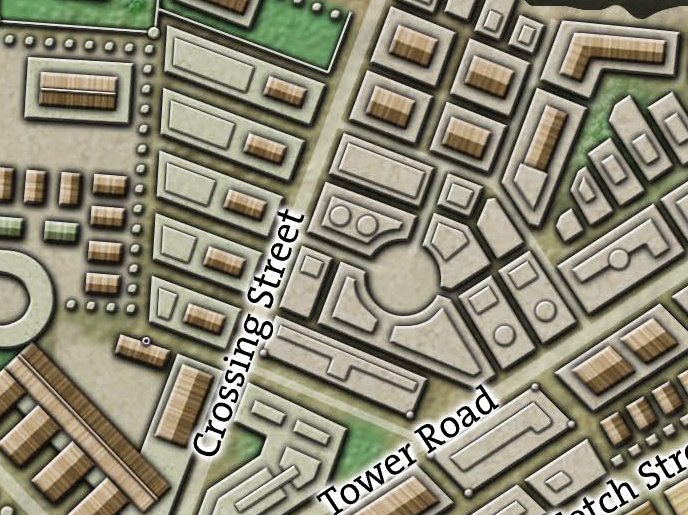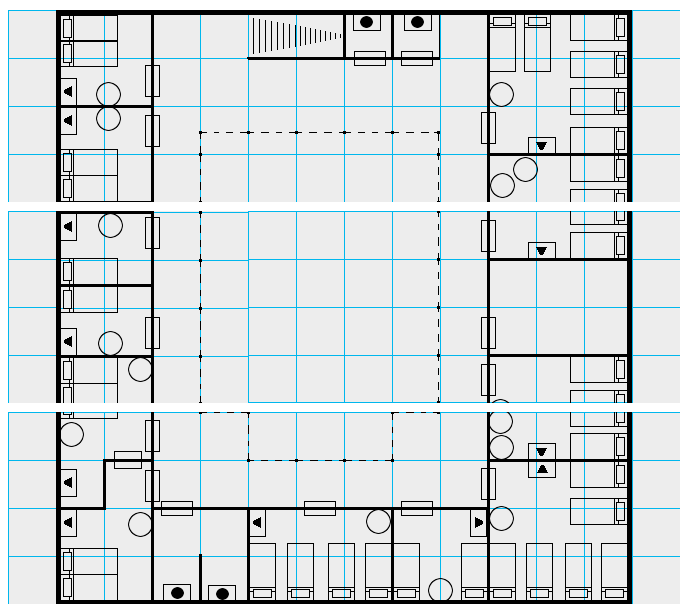DISCUSSING
In the Shadow of the Spire – Session 27B: Sights of Venom
Ranthir used his more powerful spell of clairvoyance to peer into the room… and there, standing in the midst of wrecked furniture and miscellaneous debris, he saw two massive, insectoid creatures.
At the sight, he blanched.
As he watched, one of the creatures reached out with its sharp talon and literally drilled the still-drafting curtain into the wall, pinning it in place.
In our last installment of Running the Campaign, we talked about what happens when the PCs miss clues. That actually continues into this section of the session: The project site (i.e., the apartment building controlled by cultists) had been prepped using status quo design. That meant that everything inside the building was basically held in a state of plausible stasis up until the point that the PCs interacted with it.
Once Ranthir cast his clairvoyance spells, therefore, and peeked inside, that status quo was disrupted and events started playing out. One of those events was the argument between members of the Ebon Hand and the Brotherhood of Venom. My anticipation had been that some very important information would get dropped during this conversation (i.e., clues), but because Ranthir was (a) using a spell which only granted sight, not sound; and (b) he couldn’t read lips worth a damn, most of that information was forever lost.
(Well, until the PCs gained it in a different way. Three Clue Rule and all that.)
As you’ll see in future sessions, the decision here to briefly engage the project site (setting events in motion) and then almost immediately withdrawing (“Let’s get out of here.”) had a significant impact on how subsequent events would play out.
But there was also something else the PCs did here that I didn’t expect:
The apartment building being used by the cultists was one of several similar buildings lining Crossing Street. Since Ranthir would only be able to target two specific locations with his spells, they decided to scout out the other buildings to get a better sense of what the layout might be like inside the cult’s building.
This tactic emerged because I have a giant, 8-foot-long map of Ptolus hanging on my wall during sessions, which meant that the players could see exactly what these buildings looked like:
But such a moment could easily arise in any number of ways. The key point here is that the PCs unexpectedly went into a building I had not anticipated them going into.
Now what?
This, of course, is exactly why so many video games nail the doors shut on all the buildings in town.
IN THIS CASE…
In this case, the players’ proposed reason for going into the building conveniently gave me the solution: They hypothesized that the neighboring apartment buildings, although slightly different in size, would have similar floorplans to the project site. I had floorplans for the project site, so it was relatively easy for me to just use those floorplans as the basis for some quick improvisation.
This exact scenario probably won’t crop up that often for you, but the general principle can be more broadly applied: Grab a floorplan you already have prepped — from the current session or perhaps from a previous session — and use it.
Just like these apartment buildings, the similarity of the buildings can be quite diegetic: The world is filled with structures built to a common floorplan.
MAKE IT UP
Obviously the easiest thing for me to say is, “Just make it up.”
Easy to say and great if it works. But improvisation takes practice and, honestly, no matter how much practice you get, there’ll still be times when you come up dry. That’s what the rest of this article is for.
But before we dive into that stuff, a quick word about making it up: Don’t feel like the whole building needs to spring full-blown from your brow like Athena doing Doric cosplay. You can build it up over time, describing only what the PCs need to know at any given moment. As play proceeds, a sketchy understanding of the building will start filling in with details.
A few thoughts on this:
- The first thing you’re likely to need is the exterior of the building. What’s the first thing that pops into you head when you think of the building? Describe that.
- If it’s a tactical situation, a key thing here will be entrances (do more than one) and windows.
- The second thing is to think about why the PCs are interested in the building: They’ll have probably already told you. (They’re looking for the CEO’s office. Or they’re trying to get to the roof. Or they want to hack the mainframe.) Roughly speaking, where is that stuff? First floor? Basement? Top floor?
- Once they pick an entrance, describe the lobby or front room or kitchen or whatever it is they see when they go through that door.
- Once again, think about where the exits are and start getting a sketchy feeling for where they might lead (with some thought for how they might connect to the PCs’ goals).
And then proceed along those lines.
But it also doesn’t have to be that complicated!
It’s very often true that you don’t actually need a floorplan at all.
For example, if the PCs have come here to meet with the CEO, you don’t need to know the whole building. In fact, you can probably just cut straight to a scene in the CEO’s office.
On the other hand, if you do need a floorplan and you need it right now (it’s a tactical situation, you’re playing with a VTT, etc.), then you can…
GOOGLE IT
Just hit up a search engine and type in whatever building type you’re looking for plus “blueprints” or “floorplans.”
This tends to work most reliably with modern buildings, but adding “fantasy” or “science fiction” to the search can often pull up what you need. (More reliably with the former than the latter.) These days if you add “RPG,” too, you’re likely to get a full-blown battlemap more often than not.
BUILD YOUR STOCK
Instead of scrambling with image searches at the table, you can get ahead of the game by building up a supply of stock floorplans for common locations.
- 4 or 5 different houses
- 2 or 3 warehouses
- 3 or 4 offices buildings
- A shopping mall
That sort of thing.
You can make a big push to assemble this in a marathon prep session, but it’s also something you can slowly build up over time: When you prep an adventure with a house, for example, tuck the floorplan for that house into the accordion folder or computer directory where you’re keeping your generic stock of floorplans. Over time you’ll just sort of accrete what you need.
Either way, you’ll slowly develop a sense of exactly what type of floorplans you’re likely to need, and that knowledge can often transfer from one setting to another. (As can many of the floorplans, in fact. Particularly if they don’t need to be seen by the players.)
RANDOM FLOORPLANS
Another option is to use a random generator to create the floorplan you need on-the-fly.
If you poke around a bit, you can find a number of online generators, like this Random Inn Generator from Inkwell Ideas. Collect these links in your digital notes and you can get something like this with the press of a button:
Personally, I prefer a more generic generator that I can use with just dice-and-paper. You can find the tool I use in my article on Streetcrawling Tools. It provides enough of a scaffold that I can iterate the rest, but is generic enough that I generally only need the one tool. That way I don’t feel overwhelmed hunting for precisely the right tool if my stock of generic floorplans doesn’t have exactly what I’m looking for.
It’s sort of the multitool of, “Oh crap, my players just went into a random building!”
NEXT:
Campaign Journal: Session 27C – Running the Campaign: Playing to the Crowd
In the Shadow of the Spire: Index















This might be very obvious, but it occurred to me as a handy shortcut: use floorplans of places you know. I’ve lived in eight or nine houses in my life, so there’s nine floorplans right off. It’s so obvious a trick that I overlooked it for ages.
A related trick that I use for in-person games but which is also great for digital games is to have a bunch of ready at hand generic map tiles and basic maps (I have a bunch of Paizo’s maps and I love their town & wilderness ones especially) if you combine a few useful map tiles with a preprinted bigger map you can create all kinds of flexibility on short notice. Toss in a some scatter terrain and it will even be 3D and quick to set up. I especially like map tiles that are 4 x 8 inches as being big enough that just a few creates a good small outdoor encounter. I have a great set of them that I bought online and then printed on cardstock that are of a winter terrain – they have “rivers” (that work equally well as a path through the snow), trees and a few other generic pieces of landscape. But most importantly the almost all fit together with ease in an infinite variety of forms. Adding a few physical 3D trees etc and encounters are quick to set up and memorable.
In cities having maps that have a bunch of different city locations printed on the same map also make for extensive reusability – Paizo has a few that have a bunch of different warehouses or a bunch of different inns etc and I find these are also really useful.
I don’t tend to go for making elaborate layouts with map tiles (or 3D tiles) as they are harder to improvise with on the fly. But having a big stack of map tiles that can almost all fit together means I can literally just grab a random handful of them and in a few mins (if that) have an encounter space set up. In person I combine this with a thin sheet of acrylic plastic that I lay over all of my maps whether preprinted or paper – means the maps don’t shift around and they have a degree of protection from spilled drinks and food.
I did something similar several years ago for wilderness map tiles. I took some thin foamcore, scribed a 1″ grid on it, and cut it into 6″x6″ chunks. Then I used colored markers to draw in trees, small hills, light & heavy undergrowth, and so on. Different tiles have different levels of cover (some sparse, some overgrown). So for a random wilderness encounter I could just grab a few of them, toss them down more or less at random, and have an encounter area.
It was fairly useful and had potential but I wasn’t consistent in using them.
Also did something similar for dungeon terrain – a bunch of hallway segments and rooms of common sizes that I could plunk down. Useful if your vinyl battlemap is unavailable, say (maybe you’ve prepared it with a big set-piece encounter area). Kind of Dwarven Forge (very) lite.
Form follows function.
As an engineer who’s spent most of his career designing building services (plumbing, electrical, HVAC) the floor plan of a building is highly constrained by those and the structural elements.
For example, in most houses all the wet areas (kitchen, bathrooms, laundry) run down one side or the other with few if any in the centre. That’s because sewer pipes have to run with fall and the longer you make them the deeper (and more expensive) they get. They also have to connect to the utility’s infrastructure which places a practical limit on where on a site they can get to. Even for upper storeys, longer runs of sewer mean more height needed between floor and ceiling below – taller buildings cost more.
Modern office buildings are built around a central core, either at the back for buildings that back up to others or in the centre for those that span a whole block. That core contains all the things that need to travel vertically through the building: fire stairs, elevators, HVAC ducts, cables, pipes etc. There will be basement car park, plant rooms, garbage rooms and grease traps (assuming the building has a cafe). Then come the podium level(s) which are the entrance to the building, they have to give space over to circulation so people can get from the doors to the elevators. They might also have offices or shops and there might be one or more of them with an atrium in a high end building. Then come the office floors which are typically identical. Plant room level(s) at the top with pumps and fans and fire tanks. Finally we get the lift motor room and a roof with air conditioning chillers and maybe some more tanks. This is all dictated by the use of concrete and/or steel frames and non-structural facades (usually of glass) and a drive to eliminate columns which break up the flexibility of open plan offices.
This is similar for high rise apartment buildings although they will tend to have more services risers because there needs to be circulation around the core and while office workers accept that there are communist toilets in the core, apartment dwellers want their own.
Low rise masonry buildings lack the central cores and usually have fire stairs and services risers at each end. They also tend to be broken up by the need to have more frequent structural walls because they don’t rely on deep beams. It also means that the floor to floor height is lower.
Hospitals have their own constraints. The ED needs good vehicle (including ambulance) and pedestrian access and short travel distances to the operating theatres and the morgue – you don’t want to have to cross half the campus with either a person needing emergency surgery or a dead body. For the same reason, putting palatine care wards near the morgue is also a good idea and surgical wards should be closer than medical or psychiatric wards since complications of surgery tend to be fatal more often. Ideally you will have a seperate entrance for non-emergency patients and visitors, perhaps with shops and cafes – the ED is more likely to have vending machines than either of these.
Industrial buildings take this to the extreme. An oil refinery is ALL function, as is an abattoir. A factory has a process that the raw materials will follow from one end to the other (or in a U shape) so receipt and dispatch are usually seperate. Warehousing doesn’t need that and will often have a combing in and out.
Buildings built before electric lighting need to be narrow since daylight only usefully penetrates 3-6m depending on the size and orientation of the windows. Big windows are great for letting light in but they also let the heat out (or in, depending on which is a bigger problem for the climate) so they are a compromise. Also, bricks were historically cheaper than glass.
Back in the “Dark Ages” (Eg: 90’s) we would occasionally move. So while looking I would take a copy of the apartment floorplans they would let me have and kept them around for Gaming. Same while house hunting too. Sure it wasn’t usually at a great scale but it was a start and those seeds are still with me today. Today you can hit up any Apartment building in your home town and get digital versions within moments. “You kids have no idea how easy you have it these days!!” *Shakes fists at clouds*